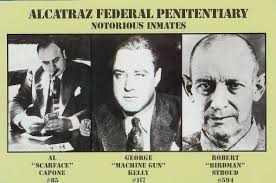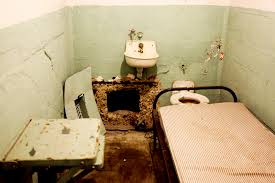Alcatraz
CELL FROM WHICH A PRISONER ESCAPED
- National Geographic – Alcatraz: No Way Out (2014) History Documentary HD
- https://youtu.be/geOhZgqzPQ4
Introduction
Images 1-9 of 9
-

-

-
 Alcatraz Cellhouse
Alcatraz Cellhouse -
 Cell Interior
Cell Interior -
 Factory Work
Factory Work -
 1962 Prison Breakout
1962 Prison Breakout -
 Alcatraz Blastout
Alcatraz Blastout -
 First Mess Hall
First Mess Hall -
 Allen Clayton West’s Fake Head
Allen Clayton West’s Fake Head
The federal prison on Alcatraz Island in the chilly waters of California’s San Francisco Bay housed some of America’s most difficult and dangerous felons during its years of operation from 1934 to 1963. Among those who served time at the maximum-security facility were the notorious gangster Al “Scarface” Capone (1899-1947) and murderer Robert “Birdman of Alcatraz” Stroud (1890-1963). No inmate ever successfully escaped The Rock, as the prison was nicknamed, although more than a dozen known attempts were made over the years. After the prison was shut down due to high operating costs, the island was occupied for almost two years, starting in 1969, by a group of Native-American activists. Today, historic Alcatraz Island, which was also the site of a U.S. military prison from the late 1850s to 1933, is a popular tourist destination.
In 1775, Spanish explorer Juan Manuel de Ayala (1745-97) mapped and named rugged Alcatraz Island, christening it La Isla de los Alcatraces, or Island of the Pelicans, due to its large population of sea birds. Seventy-five years later, in 1850, President Millard Fillmore (1800-74) signed an order reserving the island for military use. During the 1850s, a fortress was constructed on Alcatraz and some 100 cannons were installed around the island to protect San Francisco Bay. Also during this time, Alcatraz became home to the West Coast’s first operational lighthouse.
By the late 1850s, the U.S. Army had begun holding military prisoners at Alcatraz. Isolated from the mainland by the cold, strong waters of San Francisco Bay, the island was deemed an ideal location for a prison. It was assumed no Alcatraz inmate could attempt to escape by swimming and survive.
During its years as a military prison, the inmates at Alcatraz included Confederate sympathizers and citizens accused of treason during the American Civil War (1861-65). Alcatraz also housed a number of “rebellious” American Indians, including 19 Hopis from the Arizona Territory who were sent to the prison in 1895 following land disagreements with the federal government. The inmate population at Alcatraz continued to rise during the Spanish-American War (1898).
During the early 20th century, inmate labor fueled the construction of a new cellhouse (the 600-cell structure still stands today) on Alcatraz, along with a hospital, mess hall and other prison buildings. According to the National Park Service, when this new complex was finished in 1912 it was the world’s largest reinforced concrete building.
Doing Time as a Federal Prison: 1934-63
In 1933, the Army relinquished Alcatraz to the U.S. Justice Department, which wanted a federal prison that could house a criminal population too difficult or dangerous to be handled by other U.S. penitentiaries. Following construction to make the existing complex at Alcatraz more secure, the maximum-security facility officially opened on July 1, 1934. The first warden, James A. Johnston (1874-1954), hired approximately one guard for every three prisoners. Each prisoner had his own cell.
The Federal Bureau of Prisons (BOP) viewed Alcatraz as “the prison system’s prison,” a place where the most disruptive inmates could be sent to live under sparse conditions with few privileges in order to learn how to follow rules (at which point, they could be transferred to other federal prisons to complete their sentences). According to the BOP, Alcatraz typically held some 260 to 275 prisoners, which represented less than 1 percent of the entire federal inmate population.
Famous Inmates
Among those who did time at The Rock was the notorious Prohibition-era gangster Al “Scarface” Capone, who spent four-and-a-half years there during the 1930s. His arrival on the island generated headlines across America. Capone was sent to Alcatraz because his incarceration in Atlanta, Georgia, had allowed him to remain in contact with the outside world and continue to run his criminal operation in Chicago. He was also known to corrupt prison officers. All of that ended when he was sent to Alcatraz. According to the biography “Capone” by John Kobler, Capone once told the warden, “It looks like Alcatraz has got me licked.”
Other famous (or infamous) Alcatraz inmates included George “Machine Gun” Kelly (1895-1954), who spent 17 years there on a kidnapping conviction. Gangster Alvin “Creepy Karpis” Karpowicz (1907-79), listed as “Public Enemy No. 1″ by the FBI in the 1930s, spent over 25 years behind bars at Alcatraz, reportedly more time than any other prisoner. Murderer Robert Stroud, also known as the “Birdman of Alcatraz,” was transferred there after three decades at the federal penitentiary in Leavenworth, Kansas. Stroud arrived on the island in 1942 and served 17 years there; however, despite his nickname, he was not permitted to keep birds at Alcatraz as he had while locked up at Leavenworth.
Escape Attempts from Alcatraz
Over the years, there were 14 known attempts to escape from Alcatraz, involving 36 inmates. The Federal Bureau of Prisons reports that of these would-be escapees, 23 were captured, six were shot and killed during their attempted getaways, two drowned and five went missing and were presumed drowned.
The most famous escape attempt resulted in a battle, from May 2 to May 4, 1946, in which six prisoners overpowered cellhouse officers and were able to gain access to weapons, but not the keys needed to leave the prison. In the ensuing battle, the prisoners killed two correctional officers and injured 18 others. The U.S. Marines were called in, and the battle ended with the deaths of three of the rogue inmates and the trial of the three others, two of whom received the death penalty for their actions.
The Prison Closes Its Doors: 1963
The federal penitentiary at Alcatraz was shut down in 1963 because its operating expenses were much higher than those of other federal facilities at the time. (The prison’s island location meant all food and supplies had to be shipped in, at great expense.) Furthermore, the isolated island buildings were beginning to crumble due to exposure to the salty sea air. During nearly three decades of operation, Alcatraz housed a total of 1,576 men.
In 1969, a group of Native Americans led by Mohawk activist Richard Oakes (1942-72) arrived on Alcatraz Island and claimed the land on behalf of “Indians of All Tribes.” The activists hoped to establish a university and a museum on the island. Oakes left Alcatraz following the death there of his stepdaughter in 1970, and the remaining occupiers, whose ranks had become increasingly contentious and divided, were removed by order of President Richard M. Nixon (1913-94) in 1971. The island became part of the Golden Gate National Recreation Area in 1972 and was opened to the public a year later. Today, some 1 million tourists visit Alcatraz each year.
The final days of Alcatraz revealed in new photographs released for 50th anniversary of prison closing its doors for good
Its fascination for the public remains though, as millions travel to San Francisco Bay to take in a glimpse of the cells which held the country’s most dangerous criminals such as – Al Capone, George ‘Machine Gun’ Kelly and Alvin ‘Creepy’ Karpis.
And on Thursday, The National Park Service celebrated the 50th anniversary of Alcatraz Island’s closure as a federal penitentiary with an exhibit of newly discovered photos of the prison’s final hours.

In this March 21, 1963 photo taken by Leigh Wiener and provided by the National Park Service, prison guard Jim Albright, (second from left), leads out the last prisoners from Alcatraz federal penitentiary
On that day in 1963, prison guard Jim Albright led the Navy-coat clad prisoners — considered the nation’s most dangerous — to waiting boats as cameras clicked and hundreds of reporters chronicled The Rock’s last hours as a prison.
Albright wasn’t deterred by the ruckus, keeping his eye on his wards and his focus steely.
The ceremony marking the 50th anniversary of the closing was attended by former guard Jim Albright, who can be seen in the photographs in a light gray suit and dark tie, walking the shackled prisoners past reporters.

New discovered photos show the last prisoners depart from Alcatraz Island federal prison in San Francisco. The National Park Service on Thursday celebrated the 50th anniversary of Alcatraz Island’s closure with an exhibit of the photos
He had been a guard during two escapes, including the one made famous in the movie ‘Escape from Alcatraz,’ and was keeping an eye open for any funny business involving the prisoners and reporters.
‘What I was worried about was that one of these god-darned fools was going to give the inmates something that they could get out of their cuffs with,’ Albright, now 77, said. ‘These were all the worst bad guys. If you messed up somewhere else you came to Alcatraz.’
Alcatraz started as a fortress and became an Army disciplinary barracks before the Bureau of Prisons took it over in 1934 to house America’s most notorious criminals.
U.S. Attorney General Robert Kennedy signed an order in 1962 to close the prison due to its expensive upkeep and its prime location in the bay.

A flag flies on a ferry as it approaches Alcatraz Island on the day The National Park Service marked the 50th anniversary of the closure of the notorious Alcatraz federal penitentiary with an exhibit of newly discovered photos

Tourists view an exhibit of photographs documenting the last day of Alcatraz federal penitentiary on today on the island prison

Former Alcatraz Island prison guard Jim Albright looks on while viewing an exhibit of photographs documenting the last day of Alcatraz federal penitentiary today.
Read more: http://www.dailymail.co.uk/news/article-2297271/Alcatraz-final-days-revealed-new-photos-released-50th-anniversary-prison-closing.html#ixzz3oUc9SOA6
Follow us: @MailOnline on Twitter | DailyMail on Facebook







